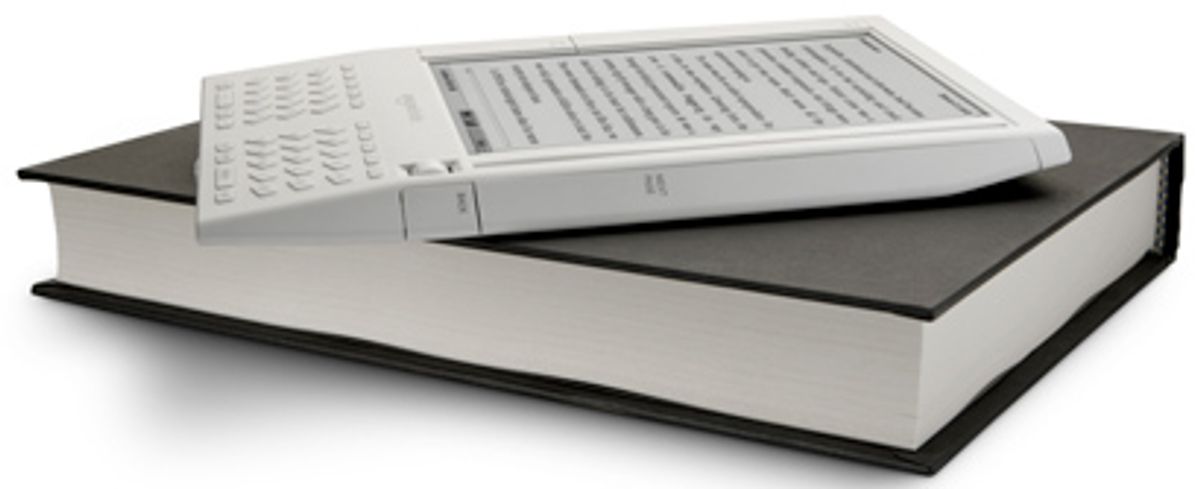
I'm in San Francisco, so I didn't get to attend Jeff Bezos' New York press event announcing the Kindle, Amazon's new e-book reader. I still haven't got my hands on one -- that'll happen tomorrow.
And really there isn't much to report on the device that we didn't go over Friday, when early word broke about Amazon's imminent launch. The best surprise -- the device lacks Wi-Fi but includes a wireless service called Amazon Whispernet, based on Sprint's EVDO protocol. The service is free -- that is, after your $399 purchase price, you pay no additional wireless charges.
Here are the specs, lifted from Amazon's Kindle product page:
Display: 6" diagonal E-Ink® electronic paper display, 600 x 800 pixel resolution at 167 ppi, 4-level gray scale
Size (in inches): 7.5" x 5.3" x 0.7"
Weight: 10.3 ounces
System requirements: None, because it doesn't require a computer
Storage: 256MB internal (approximately 185MB available for user content); available SD memory card slot supports up to 4GB SD memory cards (SD memory card not included)
Battery Life: Leave wireless on and recharge every other day. Turn wireless off and read for a week or more before recharging. Battery life will vary based on wireless usage, such as shopping the Kindle Store and downloading content. In low coverage areas or in 1xRTT only coverage, wireless usage will consume battery power more quickly.
Charge Time: Approximately 2 hours
Connectivity: EVDO modem with fallback to 1xRTT; utilizes Amazon Whispernet to provide U.S wireless coverage via Sprint's high-speed data network (Check Wireless Coverage)
USB Port: USB 2.0 (mini-B connector) to optionally connect to a PC or Macintosh computer
Audio: 3.5mm stereo audio jack, rear-mounted mono speaker
Content Formats Supported: Kindle (AZW), TXT, Audible (formats 2, 3 and 4), MP3, natively; HTML, DOC, JPEG, GIF, PNG, BMP, MOBI, PRC through conversion
Included Accessories: Power adapter, USB 2.0 cable, book cover, rechargeable battery
Documentation: About Your Kindle Manual; Kindle User's Guide pre-installed on device
Warranty and Service: 1 year limited warranty and service
And what can you read on the Kindle? Books, of course, for starters. More than 80,000 are available at the Kindle store. New releases go for $9.99 each, but many older books are less.
You can read magazines and newspapers too -- hundreds around the world are available. These will be delivered to your device with each new issue (daily for newspapers or Web mags like Salon and Slate), for a fee that ranges from about $3 for magazines to $15 for newspapers.
And you can read blogs. This is free if you use the Kindle's "experimental" Web browser, but can cost $1 or $2 for a "subscription," meaning auto-updated RSS access.
The Kindle's books are protected with DRM -- that is, they won't run on other devices. The device will open unprotected MobiPocket books, and, either through conversion or natively, it can open TXT, HTML and Microsoft Word files, according to Joel Johnson's testing. PDF files won't work.
Johnson adds that the device can play Audible's audio books, but can only get them through a USB connection with your computer -- i.e., no wireless downloading.
In its marketing efforts, Amazon is stressing two main ideas about this device. 1) It's drop-dead easy to use, and 2) It offers an experience very much like reading a book, with a display that closely mimics print, and a physical shape and overall interface that feels like a book.
Because that's a hard sell, the company asked a number of authors to use the Kindle and report back on their experiences. This is taking a page from Steve Jobs' playbook -- when it released the first iPod (and in subsequent revisions), Apple asked musicians (Moby, Madonna, Bono and others) to tell us what they loved about it.
Well, the authors love Kindle. "It's so simple you could be a moron and it works," says Michael Lewis in a promotional video. "It takes no intelligence at all. Anybody who can read a book can function with this thing."
He adds: "It's easier on the eye than the printed word," and "after about -- I'm telling you! -- 5 minutes, you cease to think, 'I'm looking at a screen.' It's not like looking at a computer screen."
Here's Toni Morrison: "I think it'll be much more attractive to walk around with an instrument in your hand and read whenever, and wherever, and how much you like. So I think it's huge!"
And Neil Gaiman: "The point that I realized that I had moved from skeptic to absolute believer in this device was with my daughter Maddy, who's 12. We were on the plane, they hadn't quite shut the doors, and I thought, 'Well she's going to want something to read. And I went on to Amazon with the kindle, and downloaded a bunch of Meg Cabot books that Maddy had wanted to read. It was like having a genie."
So the Kindle is magical -- or maybe that's just what authors who get some love from Amazon say. I'll have more updates and a review when I get some time to read a Neil Gaiman book on one.
Here's Amazon's promotional video for the device:



Shares